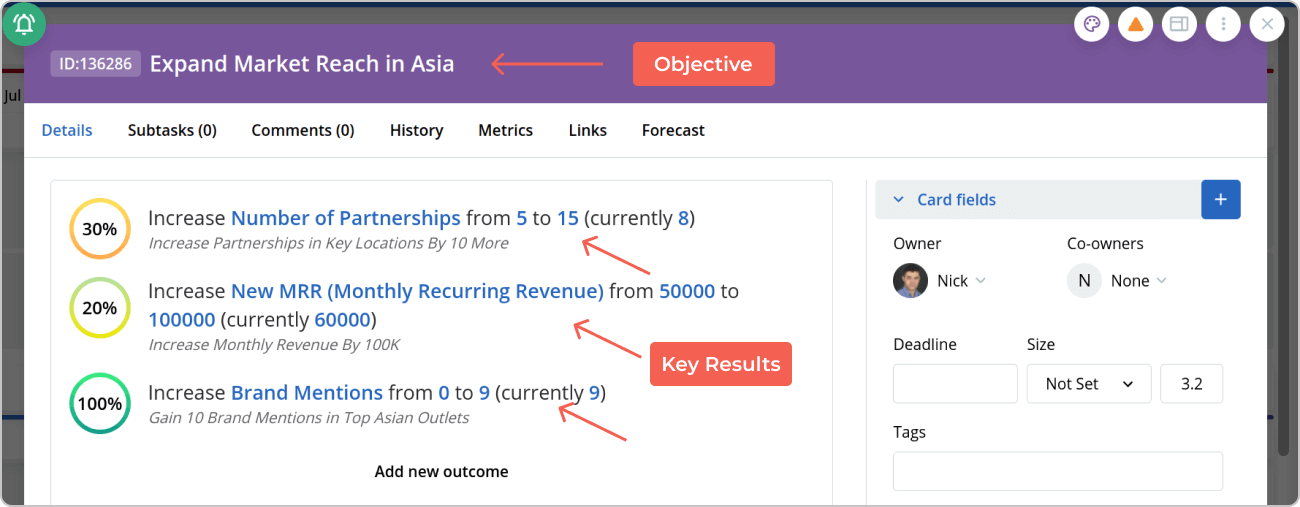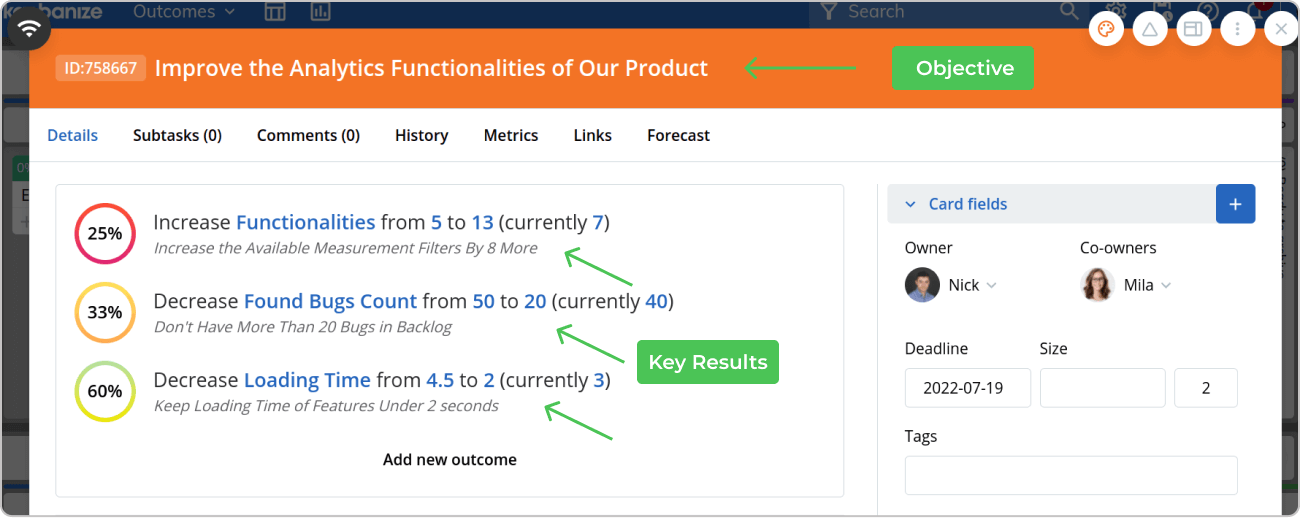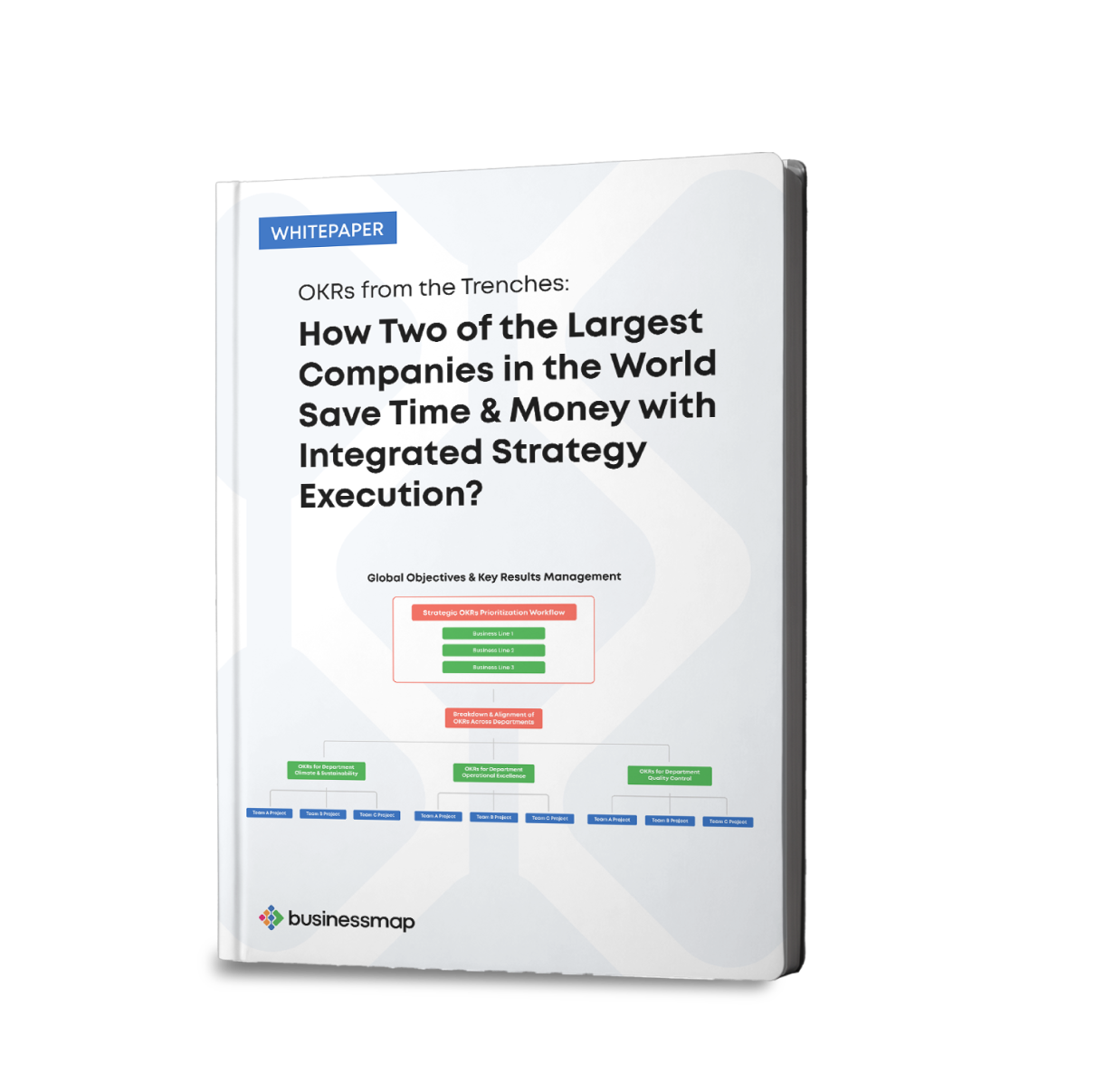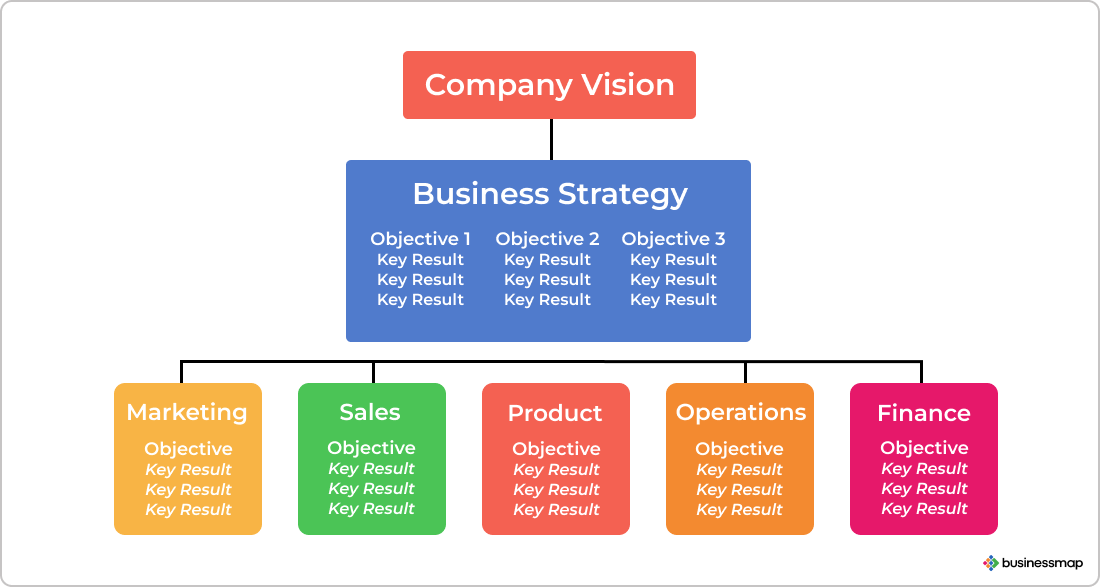Can well-structured OKRs transform your organization's performance and propel you towards your strategic goals?
In this article, we delve into real-life examples of OKRs (Objectives and Key Results) to equip you with the essentials for crafting your own effective goals. Whether you are aiming to enhance company-wide performance or improve specific team outputs, you'll find valuable insights here.
Here’s what you'll find:
- Company and Team OKRs: Learn how to align overarching company goals with team objectives to drive collective success.
- Product and Project Management OKRs: Discover how OKRs can streamline project workflows and product development cycles.
- Engineering and IT Operations OKRs: See examples of how technical teams use OKRs to boost efficiency and innovation.
- Marketing and Sales OKRs: Find out how marketing and sales teams leverage OKRs to achieve targets and accelerate growth.
What Is the OKR Format?
The structure of the OKR model consists of 2 main components - Objectives and Key Results.
- The Objective is a concise, inspirational, and ambitious statement representing your goal.
- Key Results are a few quantitative, measurable, and specific actions to help you track the completion of the Objective.
 The OKR formula
The OKR formula
19 Real OKR Examples
At Businessmap (formerly Kanbanize), we reached out to our teammates and industry experts to gather their OKRs, and we’re excited to share 19 real examples with you. These insights provide a practical glimpse into how teams set and pursue their objectives. We hope they inspire you and offer valuable ideas you can apply to your own goals and initiatives.
1. Company OKR Example
Implementing a company OKR strategy aligns your mission and vision with clear, actionable goals. By setting ambitious objectives and tailored key results for each department, you can enhance strategic focus and drive sustainable growth.
- Objective: Expand market reach in Asia.
- Key Result 1: Increase partnerships in key locations by 10 more.
- Key Result 2: Increase monthly revenue of $100K.
- Key Result 3: Gain 10 brand mentions in top Asian outlets.
 Visualizing company OKRs using Outcomes feature in Businessmap
Visualizing company OKRs using Outcomes feature in Businessmap
2. Team OKR Example
Department and team OKRs drive long-term organizational goals. They outline the actions teams will take and the results needed to make a strategic impact. Typically reviewed quarterly, OKRs in dynamic markets may need monthly updates. Let's look at an example from a product team.
- Objective: Improve the analytics functionalities of our product.
- Key Result 1: Increase the available measurement filters by 8 more.
- Key Result 2: Limit malfunctions/bugs in the backlog to 20.
- Key Result 3: Decrease the loading time of features under 2 seconds.
 Visualizing Team OKRs using the Outcomes feature in Businessmap
Visualizing Team OKRs using the Outcomes feature in Businessmap
3. Product Team OKR Example
Objective Key Results (OKRs) play a crucial role in product management by helping product teams align their efforts with the company's objectives and user experience. Achieving this balance is a key aspect of developing effective product OKRs.
- Objective: Our UI is the most user-friendly on the market.
- Key Result 1: Gain feedback from at least 20 customers about UI improvements.
- Key Result 2: Achieve a Net Promoter Score of at least 9.0 before releasing the new user interface.
- Key Result 3: Keep UI defects less than 10% of our product backlog.
4. Project Management OKR Example
By using specific project management OKRs, project managers can align team members around common goals, track progress, and make data-driven decisions to improve project outcomes.
- Objective: Improve the reporting process efficiency.
- Key Result 1: Create 3 ready-to-use templates to report directly to stakeholders.
- Key Result 2: Reduce the number of reporting meetings.
- Key Result 3: Use a centralized system for reporting.
5. Sales OKR Example
Objective Key Results (OKRs) enhance sales strategies by focusing not just on numbers but on their impact. Sales OKRs should highlight activity levels, efficiency, effectiveness, and structure. This approach helps sales teams better understand their performance and pinpoint areas for improvement. By emphasizing these factors, teams can achieve more meaningful and sustainable success.
- Objective: Drive monthly recurring revenue (MRR) by 15% for Q4.
- Key Result 1: Increase New MRR from X to X k.
- Key Result 2: Increase our subscription size from 20k to 30k per month.
- Key Result 3: Increase sales completion quotes by 30%.
- Key Result 4: Generate 20% more SQLs.
6. Business Performance OKR Example
- Objective: Boost overall sales effectiveness.
- Key Result 1: Increase the number of New Clients from X to XX.
- Key Result 2: Increase Conversion Lead to Prospect from 30% to 60%.
- Key Result 3: Increase Average Deal Size from 372 to 600.
OKRs from the Trenches:
How Two of The Largest Organizations in the World Save Time & Money with OKRs?

7. Marketing OKR Example
Marketers must establish objectives that align with the main organizational objectives, with a specific emphasis on the fundamental performance drivers within the marketing domain. When determining marketing OKRs, it is essential to evaluate whether a metric holds significance or is merely superficial.
- Objective: Double the number of marketing qualified leads (MQS) by the next quarter.
- Key Result 1: Produce 100 MQS from organic search.
- Key Result 2: Produce 100 MQS from social media campaign.
- Key Result 3: Produce 100 MQS from email marketing.
8. Product Marketing OKR Example
Product Marketing OKRs set measurable goals and track progress for product marketing teams. They align the team's efforts with the company's overall goals, ensuring efficient work towards key objectives like increasing sales, improving product awareness, and enhancing customer satisfaction. Key results are the metrics that indicate progress toward these objectives.
- Objective: Encourage users to be more actively engaged with the product.
- Key Result 1: Produce 10 onboarding videos by the end of Q4.
- Key Result 2: Create 10 "How To" tutorials for advanced users.
- Key Result 3: Re-create all existing video tutorials to include the new product functionalities.
9. Outbound Marketing OKR Example
- Objective: Achieve 50K MRR this year from Outbound activities.
- Key Result 1: Increase MRR to X from Events.
- Key Result 2: Expand our MRR from existing clients across their sister companies.
- Key Result 3: Increase MRR from cold outreach.
10. Event Management OKR Example
- Objective: Scale revenue and brand awareness through events.
- Key Result 1: Gain 20 leads per event that our team attends.
- Key Result 2: Close 10% of all leads coming from events during the year.
- Key Result 3: Secure at least 8 media coverings over the year.
11. Customer Success OKR Example
Customer success professionals ensure users get the most out of your product or service. As customer preferences evolve, so must the demands on the customer success team. Customer success OKRs enable a proactive, goal-driven approach. By setting and tracking objectives aligned with customer needs, the team can anticipate changes and deliver outcomes that meet evolving demands.
- Objective: Be proactive with customer success.
- Key result 1: Increase average health score to above 45.
- Key result 2: Workshops roadmap agreed upon with 70% of our target accounts.
- Key result 3: Collect NPS score from workshops from at least 15% of participants.
- Key result 4: Publish 2 external and 10 internal case studies.
12. Strategic Partnerships OKR Example
Partnership OKRs are collaborative goals set by two or more teams or organizations working together towards a common objective. Partnership OKRs improve communication, alignment, and accountability across teams and are ideal for joint ventures, strategic alliances, and cross-functional projects.
- Objective: Expand strategic partnerships.
- Key Result 1: Generate X revenue from partners.
- Key Result 2: Establish 10 new partners by the end of Q4.
13. Integrations Team OKR Example
Integration and IT operations professionals are key to keeping the organization running smoothly. A major challenge is prioritizing tasks that drive growth. To tackle this, they use OKRs to align their efforts with the overall strategy, focusing on the most important work. This helps achieve measurable results that support organizational goals.
- Objective: Enhance the reliability and efficiency of integration processes.
- Key Result 1: Keep integration incidents under 10 per Month.
- Key Result 2: Improve Jira Projects Data Migration Time by 25%.
14. Support OKR Example
Support OKRs set clear goals for support teams that align with the company's objectives. They focus on key metrics like customer satisfaction, response times, and issue resolution rates. This system ensures the support team prioritizes the right tasks and works towards the company's mission and goals, driving measurable success.
- Objective: Create a customer knowledge base/help center second to none.
- Key Result 1: Reduce article re-works by 30%.
- Key Result 2: Increase article view/article comments by xx%, compared to Q3.
- Key Result 3: Create video tutorials to illustrate the 10 most frequently asked questions.
15. Customer Satisfaction OKR Example
- Objective: Ensure customer satisfaction in Q4.
- Key Result 1: Increase customer feedback forms received to 40 per month (120 per Q).
- Key Result 2: Decrease negative feedback by 10%, compared to Q3.
16. Engineering OKR Example
Engineers and software developers focus on optimizing performance and reducing bottlenecks. Engineering OKRs should aim to minimize errors, enhance user experience, and streamline processes. Outcome-based key results are ideal as they emphasize performance over output, making it easier to validate success.
- Objective: Improve the predictability of software releases.
- Key Result 1: Decrease the number of patches to 1 per month.
- Key Result 2: Reduce the amount of blocked user stories by 40% to improve their flow.
- Key Result 3: Improve release frequency to every 30 days.
17. Product Development Team OKR Example
- Objective: Launch a successful AI feature for the product.
- Key Result 1: Achieve a 20% active user adoption rate for the AI feature within 3 months of launch.
- Key Result 2: Achieve an average Net Promoter Score (NPS) of 70 for the AI feature within 6 months of launch.
- Key Result 3: Increase average purchase value by 10% for users who engage with the AI recommendations.
18. Finance OKR Example
Prioritizing outcomes over outputs is crucial in finance. When setting finance OKRs, avoid vague, task-like objectives. Balancing Key Performance Indicators or KPIs with OKRs ensures your goals stay clear and focused on future outcomes, preventing them from becoming too subjective. This approach helps maintain a results-driven strategy that aligns with your financial goals.
- Objective: Improve expense management reporting.
- Key Result 1: Identify the most frequent expense types and create expense categories for everyone to use.
- Key Result 2: Create expense templates and share them with everyone.
- Key Result 3: Reduce the operational time required for expense reporting.
19. HR OKR Example
The HR department ensures every team member is prepared and motivated to achieve the organization's vision and mission. Using OKRs creates a transparent framework, helping employees understand the company's core purpose and providing them with a clear sense of direction and meaning in their work.
- Objective: Ensure faster and better onboarding of new employees.
- Key Result 1: Interview the last 10 hired team members to identify issues with the onboarding process.
- Key Result 2: Create an onboarding improvement plan to increase the satisfaction rate by 10%.
- Key Result 3: Reduce internal onboarding process time from 14 days to 10 days.
How to Write Effective OKRs: Key Questions to Ask
When it comes to writing effective OKRs, be sure to define and distinguish the Objective from the Key Results clearly. Remember, Objectives describe "what you want to achieve," while Key Results describe "how you are going to measure if you’re achieving the objective".
Asking the right questions is great for setting your objectives and key results.
Use the following questions when setting your Objectives:
- Is the objective inspiring?
- What are the goals we should set to support the long-term company vision?
- What strategic, team, or individual targets should we aim for?
Remember, you need transparent and cascading OKRs to communicate your business priorities across the organization better.
 Cascading objectives and key results
Cascading objectives and key results
Your Key Results statements should provide an answer to some of the following questions:
- How do we quantify the objective?
- How do we track and measure the progress?
- What are the indicators that the goal is achieved?
Even though the ultimate number of Key Results that can support an Objective is up to 5, typically, 2 or 3 statements are enough to measure your objective's success and keep your team's focus on the most critical deliverables.
Start Setting Your OKRs
Setting your first OKRs will undoubtedly require some rewriting and adjusting, at least in the beginning. A good starting point is using the OKR formula, checking the OKR best practices, or using industry OKR examples. Here's how you can do it with the help of the Outcomes and OKR management suite in Businessmap (previously known as Kanbanize).
As we wrap up our exploration of OKR examples, it's inspiring to see the growing number of OKR success stories. Among the most ambitious is the Speed and Scale project, led by engineer, venture capitalist, and Kleiner Perkins chair John Doerr. This groundbreaking initiative aims to combat the climate crisis by galvanizing global leaders into decisive action. Such visionary applications of OKRs demonstrate their potential to drive meaningful change. Let these examples motivate you to set bold objectives and achieve remarkable results in your own endeavors.
Businessmap is the most flexible software
to align work with company goals





